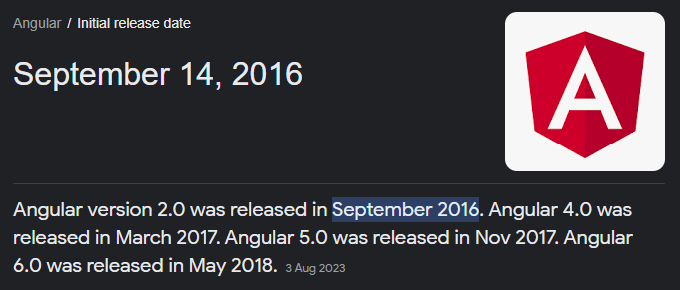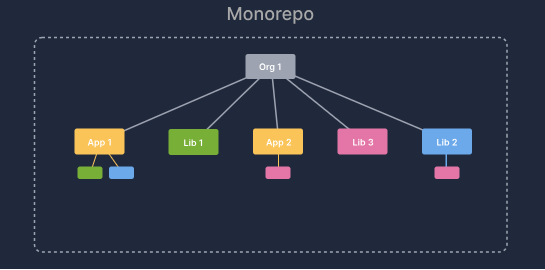The Framework of the Past, Present, and Future
Journey of Angular framework
About Me

Senior Software Enginner Celonis
GDE Angular 🅰️
GitHub Star ⭐
Nx Champion
Co-founder This is Learning
@SantoshYadavDev





# CHAPTER 2
Angular was the first framework with Typescript support


Schematics and Builders
A schematic is a template-based code generator that supports complex logic. It is a set of instructions for transforming a software project by generating or modifying code. Schematics are packaged into collections and installed with npm.
ng generate app <app_name>
ng generate lib <lib_name>
ng generate component <component_name># PRESENTING CODE
Schematics
A number of Angular CLI commands run a complex process on your code, such as linting, building, or testing. The commands use an internal tool called Architect to run CLI builders, which apply another tool to accomplish the wanted task.
"architect":{
"build":{
"builder":"@angular-devkit/build-angular:browser"
},
"serve":{
"builder":"@angular-devkit/build-angular:dev-server"
},
"test":{
"builder":"@angular-devkit/build-angular:karma"
}
}# PRESENTING CODE
Builders
Schematics and Builders API is available for developers and stable. This led to the inspiration for NxDevTools.
ref: https://monorepo.tools/

Support for authoring library
ng generate lib <lib_name># PRESENTING CODE
No setup needed
Can be published on npm
Uses Angular Package Format
Powerful @Input
Before
export class ProductListComponent {
@Input() set products(product: any) {
if(!product) {
// thorw error if product is not provided at runtime
throw new Error('Product is required');
}
}
}# PRESENTING CODE
After
export class ProductListComponent {
// throw error at compile time if product is not provided
@Input({ required: true }) products: any;
}
# PRESENTING CODE
Before
export class ProductListComponent {
@Input() set status(status: boolean) {
this._status = status ? 'Active' : 'Inactive';
}
public get status () : string {
return this._status
}
}# PRESENTING CODE
After
export class ProductListComponent {
@Input({ transform: (status: boolean) => (status ? 'Active' : 'Inactive') })
status: string = '';
}
# PRESENTING CODE
After
# PRESENTING CODE
import {
Component,
Input,
booleanAttribute,
numberAttribute,
} from '@angular/core';
export class ProductListComponent {
@Input({ transform: booleanAttribute })
status: boolean = false;
@Input({ transform: numberAttribute })
count!: number;
}
Component Authoring
Before
@Component({
selector: 'v-comment',
templateUrl: './comment.component.html',
styleUrls: ['./comment.component.scss'],
})
export class CommentComponent {
}
@NgModule({
declarations: [
CommentComponent
],
})
export class CommentModule { }
# PRESENTING CODE
After
@Component({
selector: 'v-comment',
standalone: true,
imports: [<dependent_module>, <dependent_component>]
templateUrl: './comment.component.html',
styleUrls: ['./comment.component.scss'],
})
export class CommentComponent {
}
# PRESENTING CODE
Future
@Component({
imports: [<dependent_module>, <dependent_component>]
templateUrl: './comment.component.html',
styleUrls: ['./comment.component.scss'],
})
export class CommentComponent {
}
# PRESENTING CODE
Standalone APIs
Before
@NgModule({
imports:
[
RouterModule.forRoot(routes),
HttpClientModule,
BrowserAnimationsModule
],
exports: [RouterModule],
})
export class AppRoutingModule {}# PRESENTING CODE
After
export const appConfig: ApplicationConfig = {
providers: [
provideRouter(routes),
provideHttpClient()/provideHttpClient(withFetch) -- in Developer Previee,
provideAnimations(),
],
};
bootstrapApplication(AppComponent, appConfig).catch((err) =>
console.error(err)
);
# PRESENTING CODE
Lazy loading
Before
const routes: Routes = [
{
path: 'rooms',
loadChildren: () =>
import('./rooms/rooms.module').then((m) => m.RoomsModule),
canActivate: [LoginGuard],
canLoad: [LoginGuard],
}
];
@NgModule({
imports: [RouterModule.forRoot(routes)],
exports: [RouterModule],
})
export class AppRoutingModule {}# PRESENTING CODE
After
const routes: Routes = [
{
path: 'rooms',
loadComponent: () => import('./comment/comment.component').then((m) => m.CommentComponent),
canActivate: [LoginGuard],
canLoad: [LoginGuard],
}
];
export const appConfig: ApplicationConfig = {
providers: [provideRouter(routes)]
}
bootstrapApplication(AppComponent, appConfig).catch((err) =>
console.error(err)
);# PRESENTING CODE
Migrations
ng update# PRESENTING CODE
Angular migrations
Image Optimization
@Component({
standalone: true
imports: [NgOptimizedImage],
})
class MyStandaloneComponent {}
providers: [
provideImgixLoader("https://abc.com/"),
],
<img ngSrc="logo.png" width="200" height="100"># PRESENTING CODE
Hydration
// Standalont App
export const appConfig: ApplicationConfig = {
providers: [provideClientHydration()],
};
// With Module
@NgModule({
providers: [provideClientHydration()],
})
export class AppModule {}
# PRESENTING CODE
Client Hydration
Using Services
Before
export class CommentComponent implements OnInit {
comments$ = this.commentService.getComments();
constructor(
private commentService: CommentService,
private activatedRoute: ActivatedRoute
) {}
}# PRESENTING CODE
After
export class CommentComponent implements OnInit {
comments$ = inject(CommentService).getComments();
constructor(
private activatedRoute: ActivatedRoute
) {}
}
# PRESENTING CODE
Change Detection & Signals
export const appConfig: ApplicationConfig = {
providers: [
provideExperimentalZonelessChangeDetection(),
[…]
]
}Accessing Router Data
Before
import {ActivatedRoute} from '@angular/router';
import {Observable} from 'rxjs';
import {map} from 'rxjs/operators';
@Component({
/* . . . */
})
export class ActivatedRouteComponent {
constructor(route: ActivatedRoute) {
const id: Observable<string> = route.params.pipe(map(p => p.id));
const user = route.data.pipe(map(d => d.user));
}
}# PRESENTING CODE
After
{
path: 'product/:categoryName',
loadComponent: () => import('@org/product').then((m) => m.ProductComponent),
data: {
user: 'Test User',
},
},
export const appConfig: ApplicationConfig = {
providers: [ provideRouter(
appRoutes,
withComponentInputBinding())
]
}# PRESENTING CODE
After
# PRESENTING CODE
@Component({
/* . . . */
})
export class ActivatedRouteComponent {
constructor(route: ActivatedRoute) {
@Input() user : string;
}
}What's more
esbuild support
"architect": {
"build": {
"builder": "@angular-devkit/build-angular:browser-esbuild",
}# PRESENTING CODE
esbuild + vite builder support SSR, SSG
"architect": {
"build": {
"builder": "@angular-devkit/build-angular:application",
}# PRESENTING CODE
jest support for testing
"architect": {
"test": {
"builder": "@angular-devkit/build-angular:jest",
}
}# PRESENTING CODE
Control flow
<header-cmp />
@if showBody {
<body-cmp />
} @else if showSummary {
<summary-cmp />
} @else {
Nothing to see here...
}
<footer-cmp /># PRESENTING CODE
Deferred loading
@defer on viewport {
@main {
<!-- this block will be deferred until the placeholder is visible -->
<heavy-cmp />
}
@placeholder {
<img src="ph.png">
}
@loading {
<loading-spinner />
}
}# PRESENTING CODE
Thank you for having me
My GitHub Sponosors
- AppWrite - https://appwrite.io
- Umair - https://twitter.com/UmairHafeez
- Anand - https://twitter.com/AnandChowdhary
- Sunil - https://twitter.com/sunil_designer
- Darshan - https://twitter.com/dr5hn


Free Angular Courses on YT
Thank you
@SantoshYadavDev




https://slides.com/santoshyadav/angular-past-present-future